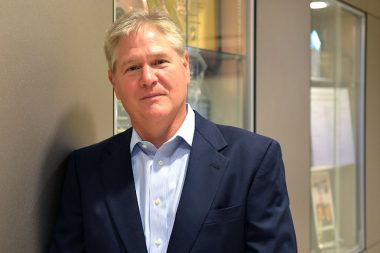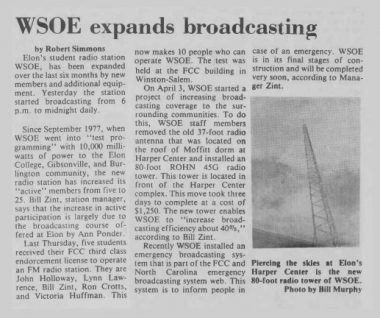Bill Zint ’79, WSOE’s first manager, reflects on the student radio station’s 1977 launch and its mission to bring together the Elon community.

Boston’s single “More Than a Feeling” has always felt right, noted Bill Zint ’79, the station’s first manager. As the track’s iconic guitar riff played out that afternoon, he recalled that students headed to their cars to listen to history.
“It just seemed perfect because at that time Boston was an unknown and WSOE was an unknown,” Zint said. “One of the big decisions we faced was what was the first song we were going to play, and ‘More Than a Feeling’ just made sense.”
The band’s self-titled debut album, powered by its popular single, became an international hit and sold more than 17 million copies in the U.S. alone. WSOE has enjoyed its own run of success, now closing in on its fourth decade on air.
A radio station without a signal
Before Boston lead singer Brad Delp serenaded students that spring day, a terrestrial radio station on Elon University’s campus wasn’t much more than a dream of a few ambitious students.
While Elon College offered its first radio class in 1922 and students began a series on WBBB, a station in Burlington, as far back as 1941, there was no actual campus platform until 1977, according to university archives. The Magazine of Elon noted efforts to start a student radio station began in the 1960s, but momentum died out until the idea was revived a decade later.

“It was just a group of passionate students and faculty advisers who had a vision to bring a radio station to campus,” Zint said. “At that time the club was working through the bureaucracy of getting a license, so we could build a station and transmit.”
Although the club didn’t have a signal, it had a vision: to build a sense of community around Elon’s students, athletics and surrounding neighbors, including Burlington and Gibsonville.
“In 1975, cellphones didn’t exist and cable TV was new – it certainly wasn’t on campus yet. The only way to really communicate was through pay phones, and that made having a radio station on campus very important,” Zint said. “We were going to interact with students in real time.”
The club’s upperclassmen did much of the initial legwork, but graduation in 1976 left Zint in charge to make WSOE, which stands for “Wonderful Sounds of Elon,” a reality.
“By default I became the station manager to lead this vision forward, but that was OK because the previous students had built so much excitement and the student government association was behind that vision. Everyone wanted it to happen,” Zint said. “That momentum continued to build and, by the spring of my sophomore year, we had achieved success. We raised the money. We built the studio. We put a tower up. And, with the help of President Fred Young, worked through the politics of getting our license to broadcast.”
Assistant Professor Gerald Gibson, a one-time WSOE faculty adviser, noted that Zint understates his influence on the station’s start.
“Without Bill there would be no WSOE,” said Gibson. “He was the constant voice advocating for a student radio station. He did all the research and writing it took for the initial funding and license. In many ways he laid the groundwork for what would become student media as we know it today.”
On the air, but now what?
While the allure of getting on air was a great initial motivator, creating content was problematic for the new student media outlet. To fill 12 hours of programming a day proved to be daunting. So challenging, in fact, that the station shut down during summer 1977.

Upon its return in fall 1977, the station was better prepared and staffed, offering programing from noon to midnight, seven days a week. Due to Federal Communications Commission rules, 50 percent of the content had to be educational programming. To fill the time, the station ran everything from multi-language programs to organic gardening segments.
In their studio in Harper Center, complete with new equipment raised through concert fundraisers and other university initiatives, the station thrived. In fact, from fall 1977 to spring 1978, the staff grew from five active members to 25, according to an April 1978 Pendulum article.
“We started to act like a real radio station,” Zint said. “By my senior year, we were just as good as any educational station on any college campus.”
Getting their hands dirty – literally
While the radio station was a success, that doesn’t mean problems didn’t arise. But a little ingenuity solved most of them – a skill the staff learned through their academic endeavors at Elon, Zint pointed out. The station’s most-dire issue was solved with a wheelbarrow, concrete and a covert operation.
To overcome a poor signal and increase its broadcasting coverage, WSOE needed to replace its old 37-foot antenna and install a new 80-foot tower, noted The Pendulum in April 1978. In fact, with the old antenna, WSOE’s radio signal to the south cut off near Elon’s post office; the towering Oaks on the historic part of campus were quite the impediment, explained Zint.
Unfortunately, the WSOE staff didn’t have permission from the university to make the tower upgrade, the station manager admitted. And because of a looming FCC transmission survey, time was of the essence.
Acknowledging that it’s a “story I’m not really proud of,” Zint and his staff members – unbeknown to university facilities – dug a hole by hand outside Harper Center one Friday afternoon. They then mixed concrete in a nearby parking lot and wheelbarrowed it over to pour a foundation. A Greensboro company completed the project’s finishing touches, installing a new tower before the end of the weekend.
Zint recalled having a stern conversation with the facilities staff the following week, but the tower stayed – with landscaping added a few days later. The station manager assumes his many pleas proclaiming the station’s significance won over school administrators.
“No one ever talked about where the tower came from,” Zint laughed. “Until they tore Harper down, I would always look at that tower and be a little embarrassed. But the station was important, and the administrators and staff understood how important it was to us and to the Elon community.”


